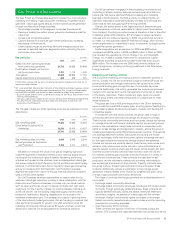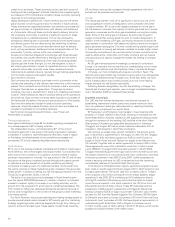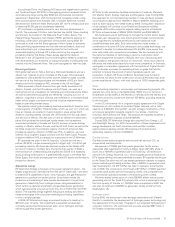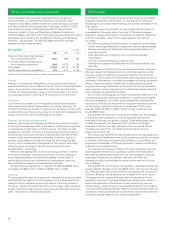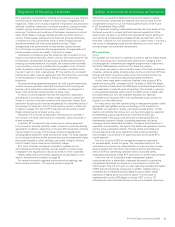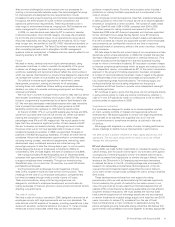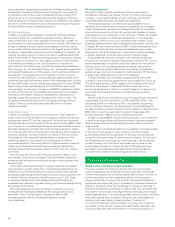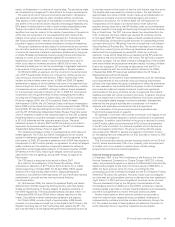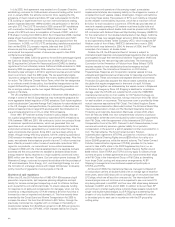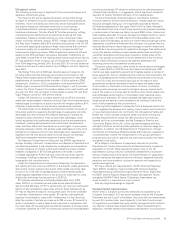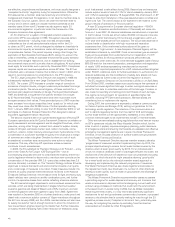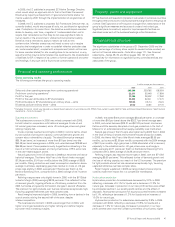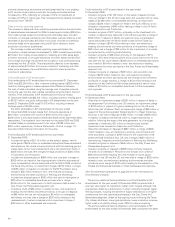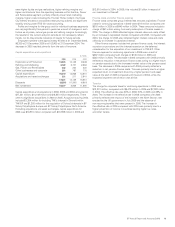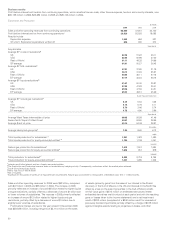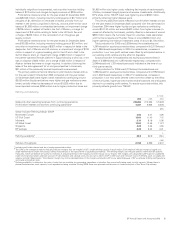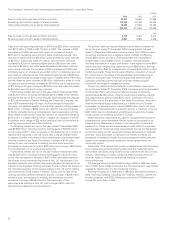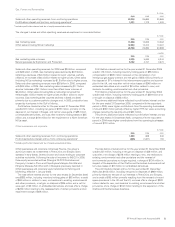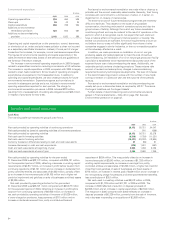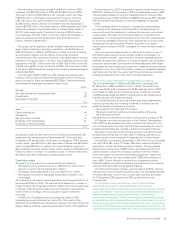BP 2006 Annual Report Download - page 47
Download and view the complete annual report
Please find page 47 of the 2006 BP annual report below. You can navigate through the pages in the report by either clicking on the pages listed below, or by using the keyword search tool below to find specific information within the annual report.US regional review
The following is a summary of significant US environmental issues and
legislation affecting the group.
The Clean Air Act and its regulations require, among other things,
stringent air emission limits and operating permits for chemicals plants,
refineries, marine and distribution terminals; stricter fuel specifications
and sulphur reductions; enhanced monitoring of major sources
of specified pollutants; and risk management plans for storage of
hazardous substances. This law affects BP facilities producing, refining,
manufacturing and distributing oil and products as well as the fuels
themselves. Federal and state controls on ozone, particulate matter,
carbon monoxide, benzene, sulphur, MTBE, nitrogen dioxide, oxygenates
and Reid Vapor Pressure affect BP’s activities and products in the US. BP
is continually adapting its business to these rules and has the know-how
to produce quality and competitive products in compliance with their
requirements. Beginning January 2006, all gasoline produced by BP was
subject to the EPA’s stringent low-sulphur standards. Furthermore, by
June 2006, at least 80% of the highway diesel fuel produced each year by
BP was required to meet a sulphur cap of 15 parts per million (ppm) and
then 100% beginning January 2010. By June 2007, all non-road diesel fuel
production will have to meet a sulphur cap of 500ppm and then 15ppm by
June 2012.
The Energy Policy Act of 2005 also required several changes to the
US fuels market with the following fuel provisions: elimination of the
Federal Reformulated Gasoline (RFG) oxygen requirement in May 2006;
establishment of a renewable fuels mandate – 4 billion gallons in 2006,
increasing to 7.5 billion in 2012; consolidation of the summertime RFG
Volatile organic compound (VOC) standards for Region 1 and 2; provision
to allow the Ozone Transport Commission states on the east coast to opt
any area into RFG; and a provision to allow states to repeal the 1psi Reid
Vapor Pressure waiver for 10% ethanol blends.
In 2001, BP entered into a consent decree with the EPA and several
states that settled alleged violations of various Clean Air Act requirements
related largely to emissions of sulphur dioxide and nitrogen oxides at BP’s
refineries. Implementation of the decree’s requirements continues.
The Clean Water Act is designed to protect and enhance the quality of
US surface waters by regulating the discharge of wastewater and other
discharges from both onshore and offshore operations. Facilities are
required to obtain permits for most surface water discharges, install
control equipment and implement operational controls and preventative
measures, including spill prevention and control plans. Requirements
under the Clean Water Act have become more stringent in recent years,
including coverage of storm and surface water discharges at many more
facilities and increased control of toxic discharges. New regulations are
expected over the next several years that could require, for example,
additional wastewater treatment systems at some facilities.
The Resource Conservation and Recovery Act (RCRA) regulates the
storage, handling, treatment, transportation and disposal of hazardous and
non-hazardous wastes. It also requires the investigation and remediation
of certain locations at a facility where such wastes have been handled,
released or disposed of. BP facilities generate and handle a number
of wastes regulated by RCRA and have units that have been used for
the storage, handling or disposal of RCRA wastes that are subject to
investigation and corrective action.
Under the Comprehensive Environmental Response, Compensation,
and Liability Act (also known as CERCLA or Superfund), waste generators,
site owners, facility operators and certain other parties are strictly liable
for part or all of the cost of addressing sites contaminated by spills or
waste disposal regardless of fault or the amount of waste sent to a site.
Additionally, each state has laws similar to CERCLA.
BP has been identified as a Potentially Responsible Party (PRP)
under CERCLA or otherwise named under similar state statutes at
approximately 800 sites. A PRP or named party can incur joint and several
liability for site remediation costs under some of these statutes and so
BP may be required to assume, among other costs, the share attributed
to insolvent, unidentified or other parties. BP has the most significant
exposure for remediation costs at 60 of these sites. For the remaining
sites, the number of parties can range up to 200 or more. BP expects its
share of remediation costs at these sites to be small in comparison with
the major sites. BP has estimated its potential exposure at all sites where
it has been identified as a PRP or is otherwise named and has established
provisions accordingly. BP does not anticipate that its ultimate exposure
at these sites individually, or in aggregate, will be significant, except as
reported for Atlantic Richfield Company in the matters below.
The US and the State of Montana seek to hold Atlantic Richfield
Company liable for environmental remediation, related costs and natural
resource damages arising out of mining-related activities by Atlantic
Richfield’s predecessors in the upper Clark Fork River Basin (the basin).
The estimated future cost of performing selected and proposed remedies
in certain areas in the basin are likely to exceed $350 million. Federal and
state trustees also seek to recover damages for alleged injuries to natural
resources in the basin. In 1999, Atlantic Richfield settled most of the
State’s claims for damages, as well as all natural resource damage claims
asserted by a local Native American tribe. However, the parties have not
resolved the claims for natural resource damages on certain federal land
or the State’s remaining claims for restoration damages. Past settlements
among the parties, including consent decree settlements providing for
combined remediation and restoration projects in limited areas of the
basin, may provide a framework for future settlement of the remaining
claims. Atlantic Richfield Company has asserted defences to the
remaining claims and has asserted counterclaims.
The group is also subject to other claims for natural resource damages
(NRD) under CERCLA, OPA 90, and other federal and state laws. NRD
claims have been asserted by government trustees against a number of
group operations. This is a developing area of the law that could affect the
cost of addressing environmental conditions at some sites in the future.
In the US, many environmental clean-ups are the result of strict
groundwater protection standards at both the state and federal level.
Contamination or the threat of contamination of current or potential
drinking water resources can result in stringent clean-up requirements
even if the water is not being used for drinking water. Some states have
even addressed contamination of non-potable water resources using
similarly strict standards. BP has encouraged risk-based approaches to
these issues and seeks to tailor remedies at its facilities to match the
level of risk presented by the contamination.
Other significant legislation includes the Toxic Substances Control Act,
which regulates the development, testing, import, export and introduction
of new chemical products into commerce; the Occupational Safety and
Health Act, which imposes workplace safety and health, training and
process requirements to reduce the risks of physical and chemical
hazards and injury to employees; and the Emergency Planning and
Community Right-to-Know Act, which requires emergency planning
and spill notification as well as public disclosure of chemical usage and
emissions. In addition, the US Department of Transportation, through
the Pipeline and Hazardous Materials Safety Administration, regulates in
a comprehensive manner the transportation of the group’s petroleum
products such as crude oil, gasoline and chemicals to protect the health
and safety of the public.
BP is subject to the Marine Transportation Security Act and the
Department of Transportation Hazardous Materials security compliance
regulations in the US. These regulations require many of our US
businesses to conduct security vulnerability assessments and prepare
security mitigation plans that require the implementation of upgrades to
security measures, the appointment and training of designated security
personnel and the submission of plans for approval and inspection by
government agencies.
BP has a national spill response team, the BP Americas Response
Team (BART), consisting of approximately 250 trained emergency
responders at group locations throughout North America. Supporting
the BART are five Regional Response Incident Management Teams
and seven HAZMAT Strike Teams. Collectively, these teams are
ready to assist in a response to a major incident.
See also Legal proceedings on page 85.
European Union regional review
Within the EU, European Community directives are proposed by the
European Commission (EC) and usually adopted jointly by the European
Parliament and the Council of Ministers. They must then be implemented
by each EU member state. Less frequently in the field of environment,
EC regulations are adopted that apply directly throughout the EU without
the need for member state implementation. When implementing EU
legislation, member states must ensure that penalties for non-compliance
BP Annual Report and Accounts 2006 45


